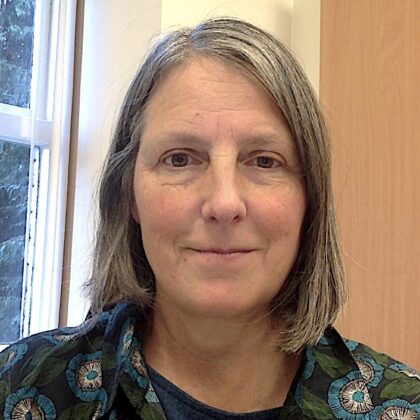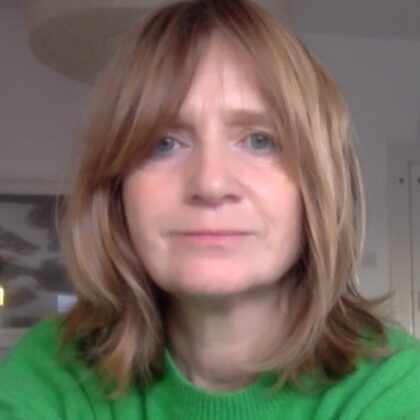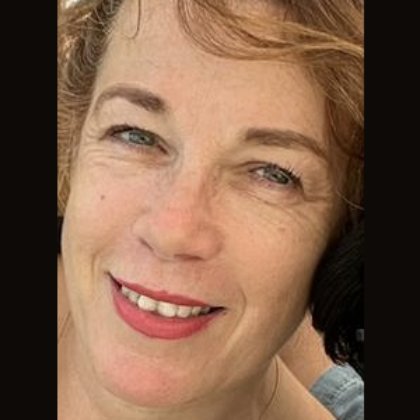Sharing approaches to art therapy with refugees (part 1)
Conversations
We invited senior art therapists Bobby Lloyd, Miriam Usiskin and new practitioner prize-winner Jess Gordon to share their approaches to working with refugees by asking each other questions about their articles, published in our journal, the International Journal of Art Therapy.
First, Bobby and Miriam put their questions to Jess, whose paper looks at the use of mobile making with a group of displaced young people from Ukraine.
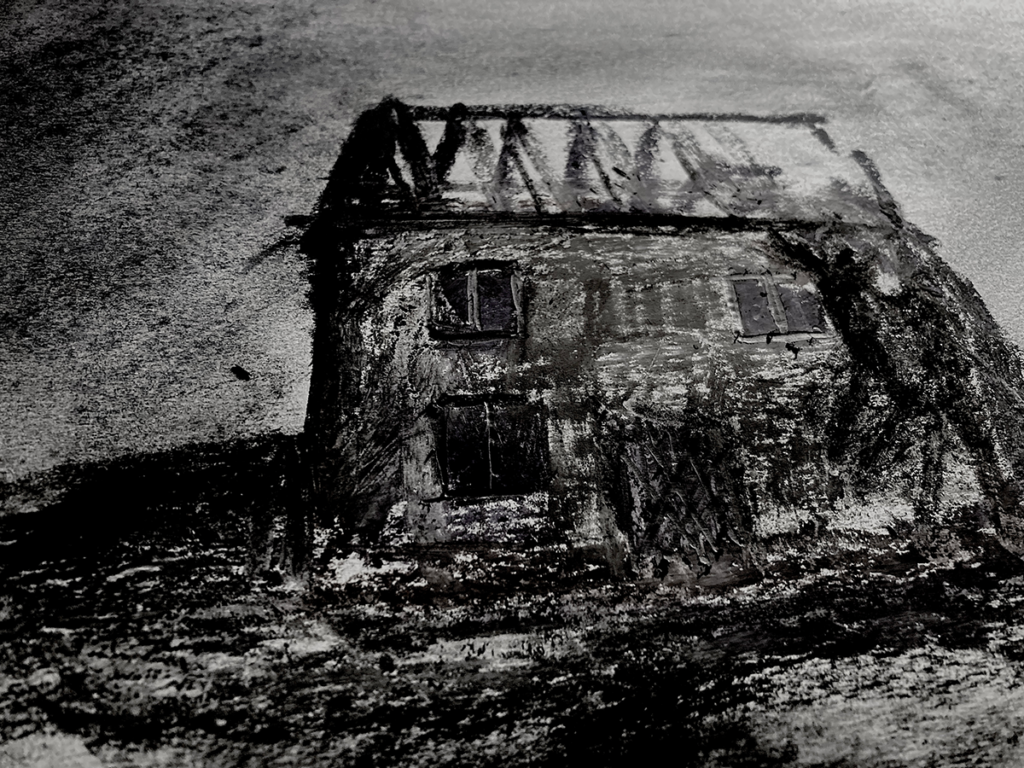
In your beautifully articulated article, you focus on your use of mobile making as a way to explore conflicting feelings around home and belonging. You describe how ‘finding ways to balance the different objects offered a concrete way to explore holding and balancing the conflicting feelings of a transitional space’. Could you envisage working with these ideas in different ways beyond the mobile activity with people who are displaced; and if so, in what ways?
Bobby and Miriam
Jess: I find that in working with displaced people the challenge lies in tolerating the ‘not knowing’. The temptation is to offer positives to counter the uncertainty. There is, of course, a place for problem-solving and resource-spotting, but validating the discomfort of being in that liminal space needs, I think, to come first.
With one group, we shared metaphors – drawing, writing or modelling them – for how they were feeling:
… a snail without a shell
… a tightrope walker without a safety net with a sea of sharks underneath me
… an empty house without a roof and no lights.
At the end of the session, so as not to remain in that state of discomfort, we reflected on how it felt to add the shell, safety net or roof to the image or model.
Another time I brought in a bag of wooden Jenga blocks – small ones that could be easily decorated using pens and coloured markers. I invited the group to think about the things that made up ‘home’ for them: feelings, people, objects, memories. I asked the group to each draw or write these things on a separate block.
When they had finished, I invited them to use the blocks to build a home, thinking about where each thing should go. What made the foundations? What framed the windows and built the walls? We then explored taking the houses apart and dividing the blocks into two piles: things that had been left behind and things that they had been able to bring with them. We looked together at what was left (often very small piles) and reflected on how it felt. Then we thought about the essentials of home. Did they still have those and, if not, could they be found in the new environment? Were there other things that, though different, might be good enough substitutes? How long would it take to build the new house and who might be able to help?

You stress the importance of a strength-based approach focusing on resilience and empowerment when working with displaced young people, and that this needs to be a collaborative process. In our own work with people who are displaced we have seen how social and cultural connection are key elements of psychosocial support. If you were to offer the mobile activity again, could you envisage collaborative mobile making taking place in small or large groups, supported by materials that reflect the culture of those attending and by the processes emerging, so as to reinforce this approach?
Bobby and Miriam
Jess: I love the idea of collaborative mobile making. I think it would be particularly helpful to see how the processes emerging from within the group, for example around problem-sharing and -solving, mutual support and expressing identity, might, on reflection, be applied to other situations. In contexts where displaced people are heavily reliant on the host country or foreign agencies for support, it would be empowering for the group to know it could draw on its own resources.
I think there is more thinking to be done around the objects used in this activity. I tried to bring materials that were either culturally ‘neutral’ or at least transferable. Many of the girls had talked about the importance of the natural world and time spent outside, so I brought natural objects that they might relate to, like sticks, stones and shells. Fabric and embroidery, wool and threads are significant in Ukrainian culture, so I included those too, but I was aware that I was guessing at what would be meaningful for them. Neutral objects have the advantage of being open to many interpretations; the feather has been variously interpreted as protection (a mother keeping her daughter ‘under her wing’), flight and freedom, migration or ‘lightness’. Stones were popular as embodying the ‘weight’ of the challenges faced.
Perhaps an extension of the activity could be to explore with participants what objects resonate with them. Is it important to have culturally specific objects? Is it equally important to have ‘alien’ objects that belong to the host country? For some people the process of making the objects was more significant. They noticed, for example, how the complexity and frustration of winding a thread around a wire frame mirrored the complexity and frustration of navigating relationships within school. The value here lies not only in the insights gained, but in learning to take that step back and reflect.

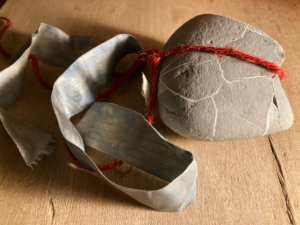
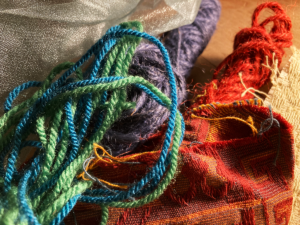
You mention that the school’s wellbeing suite was available all day and that it was used by members of the group as a safe haven. Ownership of the space had a positive effect on the young people’s sense of agency within the therapy sessions and on the therapeutic alliance. Can you say more about this, and also comment more broadly on the role of space when working with issues of displacement?
Bobby and Miriam
Jess: The question ‘Where do I belong?’ came up repeatedly in this work; in some sense it was the central theme. Displacement from home feels to me particularly challenging in adolescence; just when a young person needs to explore the world from the security of a safe base and in the company of peers, both safe base and peers are removed. These young Ukrainians did not feel safe in school. They were bullied and excluded, de-skilled by needing to function in a foreign language and constantly aware of their status as ‘guests’. Not knowing if displacement was temporary or permanent brought additional challenges: was it safe to start putting down new roots or would they be torn up again?
In a fleeting way, we offered the therapy space as a temporary ‘home’. We reversed the power dynamic in a way because other students were excluded from the space while we were using it. We used their language (I was the one struggling as the only non-Russian speaker). They had choice and control; they made the rules. At times we felt like the parents waiting at home while the teenagers went out to the other room or occupied the corridor.
I think the question of where art therapy happens and who ‘owns’ that space is an interesting one. During the Covid-19 pandemic, art therapy itself was ‘displaced’ from its usual spaces. Online therapy suddenly challenged the model of clients entering the therapist’s space and leaving the artworks at the end of the session. That model ensures confidentiality, but also creates a power dynamic that invests the therapist with ownership and control. Working online, that dynamic shifts. There seems to me to be a relationship between online working and working in transitory spaces in how the sessions can become more collaborative. The space itself belongs to neither or both. Maybe ‘home is where the art is’. A function then of the art therapy becomes claiming the space and the right to exist in that space.
Read the articles
If you’re one of our members, you can read the articles in the International Journal of Art Therapy by Jess, and Bobby and Mirium, for free through your memberzone.
- Longing and belonging: making mobiles in art therapy with young Ukrainian refugees Jess Gordon, International Journal of Art Therapy (2023)
- ‘Reimagining an emergency space: practice innovation within a frontline art therapy project on the France-UK border at Calais’ Bobby Lloyd and Miriam Usiskin, International Journal of Art Therapy (2020)
Part 2 coming soon
You can read Jess Gordon’s questions for Bobby Lloyd and Miriam Usiskin in the next issue of InSight, coming in Spring 2025.
